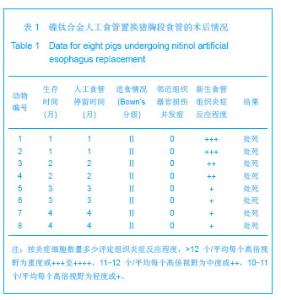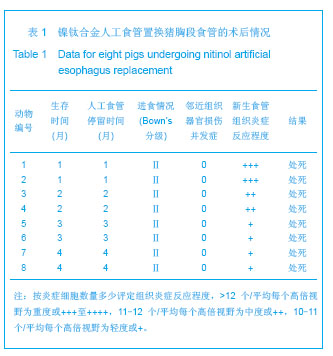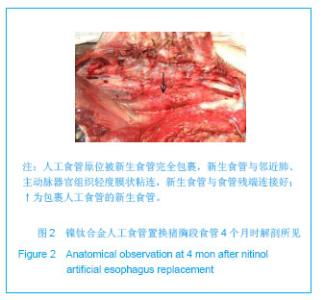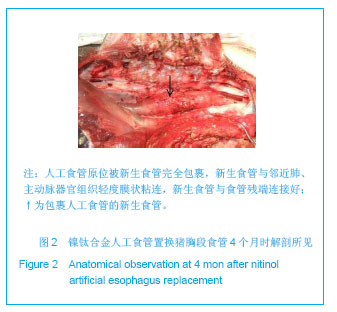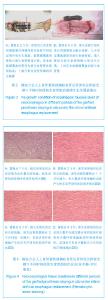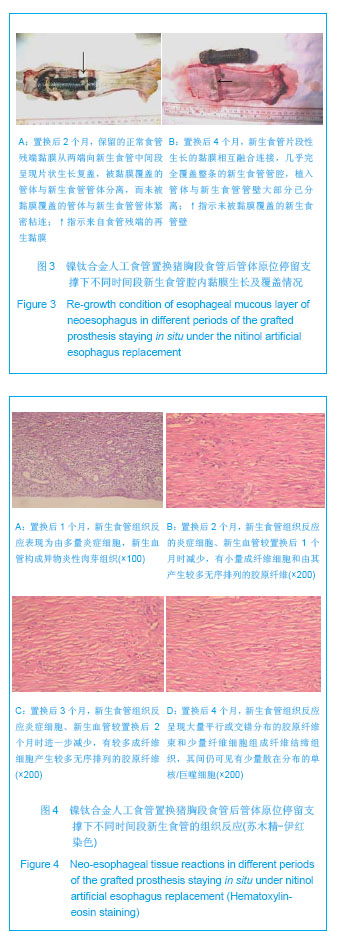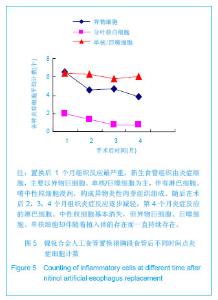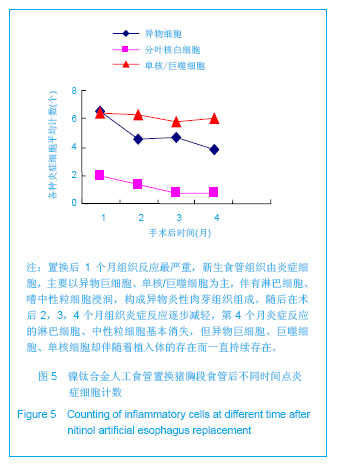| [1]Sharkawy AA,Klitzman B,Truskey GA,et al.Engineering the tissue which encapsulates subcutaneous implants. I. Diffusion properties.J Biomed Mater Res.1997; 37(3):401-412. [2]梁建辉,周星,彭品贤,等.镍钛合金组合式人工食管替代食管的实验研究[J].中华外科杂志,2006,44(14):952-955.[3]梁建辉,周星,梁显亮.人工食管脱落时间对猪新生食管通道功能形成的影响[J].中华医学杂志,2009,89(35):2509-2510.[4]Liang JH,Cai P,Luo ZR,et al. Effect of feeding regulation measures for establishing esophageal channel function in neoesophagus created with a nitinol artificial esophagus.Int J Artif Organs.2012;35(9): 671-678.[5]Bown SG,Hawes R,Matthewson K,et al.Endoscopic laser palliation for advanced Malignant dysphagia.Gut.1987;28: 799-807.[6]D'Journo XB,Martin J,Ferraro P,et al.The esophageal remnant after gastric interposition.Dis Esophagus.2008;21:377-388.[7]Ferahkose Z,Bedirli A,Kerem M,et al.Comparison of free jejuna graft with gastric pull-up reconstruction after resection of hypopharyngeal and cervical esophageal carcinoma.Dis Esophagus.2008;21:340-345.[8]Doki Y,Okada K,Miyata M,et al.Long-term and short-term evaluation of esophageal reconstruction using the colon or the jejunum in esophageal cancer patients after gastrectomy. Dis Esophagus.2008;21:132-138.[9]李辉.人工食管的研究现状及进展[J].中华临床医学杂志,2009, 3(8): 1245-1247.[10]江华,崔永,王天佑.人工食管研究的进展[J].中华外科杂志,2009, 47(20):1589-1591.[11]邓建华,肖波,任光国.人工食管的研究进展[J].肿瘤预防与治疗, 2010,23(1):78-81.[12]Berman EF.The experimental replacement of portions of the esophagus by a plastic tube.Ann Surg.1952;135(3):337-343.[13]沈冰,孙磊,江华,等.医用聚氨酯材料人工食管重建的组织再生观察[J].临床与实验病理学杂志,2011,27(10):1099-1102.[14]崔建华,郝冰,孟晓萍.猪多层细胞外基质(ECM) 人工食管的动物实验研究[J].中国实验诊断学,2009,13(2):173-175.[15]谢远财,张本固,彭品贤,等.应用钛镍合金—硅橡胶组合式人工食管重建食管缺损[J].中国组织工程研究与临床康复,2009,13(34): 6675-6679.[16]吴强.食管组织工程前景[J].临床外科杂志,2010,18(8):514-515.[17]金雄.人工食管材料生物相容性及其临床应用的安全性[J].中国组织工程研究与临床康复,2009,13(42):8353-8356.[18]黄庆东,陈刚,石文君.自体及人工食管替代物的研究进展[J].中国组织工程研究与临床康复,2009,13(9):1687-1690.[19]洪志鹏.人工食管的基础研究进展及食管重建术的临床现状[J].昆明医学院学报, 2010,31(11):1-3. [20]李嫒嫒,刘玉新,竺亚斌,等.食道组织工程的研究进展与展望[J].中国生物医学工程学报,2010,29(6):926-931.[21]Yamamoto Y,Nakamura T,Shimizu Y,et al.Intrathoracic esophageal replacement in the dog with the use of an artificial esophagus composed of a collagen sponge with a double-layered silicone tube.J Thoracic Cardiovascular Surg. 1999;118(2):276-286.[22]张兰军,戎铁华,吴秋良,等.“新生食管”再生过程的组织学观察[J].癌症,2006,25(6):689-695.[23]Banerjee R,Nageswari K.Hematological aspects of biocompatibility-review article.J Biomat.1997;12:57.[24]秦雄,徐志飞,史宏灿,等.组织工程构建人工食管的初步实验研究[J].第二军医大学学报,2002,23(10):1134-1137.[25]Liang JH, Zhou X, Zheng ZB,et al.Polyester connecting ring improves outcome in nitinol composite artificial esophagus. ASAIO J.2009;55(5):514-518.[26]Liang JH, Zhou X, Zheng ZB,et al.Long-term form and function of neoesophagus after experimental replacement of thoracic esophagus with nitinol composite artificial esophagus. ASAIO J.2010;56(3):232-234.[27]Watanabe M, Sekine K, Hori Y,et al.Artificial esophagus with peristaltic movement. ASAIO J.2005;51(2):158-161.[28]Takimoto Y,Nakamura T,Teramachi M,et al.Replacement of long segments of the esophagus with a collagen-silicone composite tube.ASAIO J.1995; 41:M605-608.[29]黄考迈,秦文瀚,孙玉鄂.现代胸外科学[M].北京:人民军医出版社,1993:332-334. [30]Cwikiel W, Willén R, Stridbeck H,et al.Self-expanding stent in the treatment of benign esophageal stricture: experimental study in pigs and presentation of clinical cases.Radiology. 1993;187:667-671.[31]Cwikiel W, Stridbeck H, Tranberg KG, et al.Malignant esophageal strictures: treatment with a self-expanding stent.Radiology.1993;187:661-665. |
